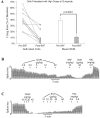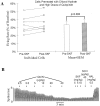D1-D2 interaction in feedback control of midbrain dopamine neurons
- PMID: 9315916
- PMCID: PMC6793911
- DOI: 10.1523/JNEUROSCI.17-20-07988.1997
D1-D2 interaction in feedback control of midbrain dopamine neurons
Abstract
Dopamine (DA) D1-like receptors are present in pathways implicated in feedback control of midbrain DA neurons. However, stimulation of these receptors either produces no effect on DA cells, or the effect is inconsistent. It is possible that the expression of a D1 feedback effect requires co-activation of D2-like receptors. To test this hypothesis, we recorded extracellularly the spontaneous activity of nigral DA cells in a low cerveau isolé rat preparation. SKF38393 and dyhydrexidine, two D1 agonists, were administered systemically to animals pretreated with different doses of the D2 agonist quinpirole. Supporting the hypothesis, the two D1 agonists consistently inhibited DA cells in animals given high doses of quinpirole (>/=40 microg/kg, i.v.). However, no significant D1 effect was observed in animals pretreated with only low doses (</=20 microg/kg) of quinpirole. Because low doses of D2 agonists preferentially act on DA autoreceptors, and because the D1 inhibition persisted in animals whose DA autoreceptors were blocked by intranigral application of raclopride, our results suggest that the expression of D1 feedback inhibition requires co-activation of D2-like receptors on DA target neurons, instead of DA neurons themselves. These results, together with the finding that chloral hydrate completely blocked the D1 inhibition, may explain why previous studies have failed to show a consistent D1 effect on DA cells and suggest that drugs designed to act specifically on one subtype of DA receptor may, via feedback pathways, influence the action of endogenous DA on other DA receptor subtypes as well.
Figures






Similar articles
-
Endogenous DA-mediated feedback inhibition of DA neurons: involvement of both D(1)- and D(2)-like receptors.Synapse. 2000 Feb;35(2):111-9. doi: 10.1002/(SICI)1098-2396(200002)35:2<111::AID-SYN3>3.0.CO;2-7. Synapse. 2000. PMID: 10611636
-
Electrophysiological verification of the presence of D1 and D2 dopamine receptors within the ventral pallidum.Synapse. 1994 Jul;17(3):160-6. doi: 10.1002/syn.890170304. Synapse. 1994. PMID: 7974198
-
D1 dopamine receptor stimulation enables the postsynaptic, but not autoreceptor, effects of D2 dopamine agonists in nigrostriatal and mesoaccumbens dopamine systems.Synapse. 1989;4(4):327-46. doi: 10.1002/syn.890040409. Synapse. 1989. PMID: 2532422
-
DA D2 receptors in the ventral striatum: multiple effects or receptor subtypes?Nihon Shinkei Seishin Yakurigaku Zasshi. 1997 Apr;17(2):91-5. Nihon Shinkei Seishin Yakurigaku Zasshi. 1997. PMID: 9201729 Review.
-
Receptor subtype-specific dopaminergic agents and unconditioned behavior.Pol J Pharmacol Pharm. 1991 Nov-Dec;43(6):507-28. Pol J Pharmacol Pharm. 1991. PMID: 1687945 Review.
Cited by
-
Dual effects of D-amphetamine on dopamine neurons mediated by dopamine and nondopamine receptors.J Neurosci. 2000 May 1;20(9):3504-11. doi: 10.1523/JNEUROSCI.20-09-03504.2000. J Neurosci. 2000. PMID: 10777813 Free PMC article.
-
A mouse model of the schizophrenia-associated 1q21.1 microdeletion syndrome exhibits altered mesolimbic dopamine transmission.Transl Psychiatry. 2017 Nov 30;7(11):1261. doi: 10.1038/s41398-017-0011-8. Transl Psychiatry. 2017. PMID: 29187755 Free PMC article.
-
Dopamine selectively inhibits the direct cortical pathway to the CA1 hippocampal region.J Neurosci. 1999 Feb 15;19(4):1437-45. doi: 10.1523/JNEUROSCI.19-04-01437.1999. J Neurosci. 1999. PMID: 9952420 Free PMC article.
-
Simultaneous dopamine and single-unit recordings reveal accumbens GABAergic responses: implications for intracranial self-stimulation.Proc Natl Acad Sci U S A. 2005 Dec 27;102(52):19150-5. doi: 10.1073/pnas.0509607102. Proc Natl Acad Sci U S A. 2005. PMID: 16380429 Free PMC article.
-
Examining the role of paraoxonase 2 in the dopaminergic system of the mouse brain.BMC Neurosci. 2022 Sep 2;23(1):52. doi: 10.1186/s12868-022-00738-4. BMC Neurosci. 2022. PMID: 36056313 Free PMC article.
References
-
- Aghajanian GK, Bunney BS. Central dopaminergic neurons: neurophysiological identification and responses to drugs. In: Usdin E, Snyder SH, editors. Frontiers in catecholamine research. Pergamon; New York: 1973. pp. 643–648.
-
- Arnt J. Behavioural stimulation is induced by separate dopamine D-1 and D-2 receptor sites in reserpine-pretreated but not in normal rats. Eur J Pharmacol. 1985;113:79–88. - PubMed
-
- Bertorello AM, Hopfield JF, Aperia A, Greengard P. Inhibition by dopamine of (Na(+)+K+)ATPase activity in neostriatal neurons through D1 and D2 dopamine receptor synergism. Nature. 1990;347:386–388. - PubMed
-
- Bolam JP, Smith Y. The GABA and substance P input to dopaminergic neurones in the substantia nigra of the rat. Brain Res. 1990;529:57–78. - PubMed
-
- Bordi F, Meller E. Enhanced behavioral stereotypies elicited by intrastriatal injection D1 and D2 dopamine agonists in intact rats. Brain Res. 1989;504:276–283. - PubMed
Publication types
MeSH terms
Substances
Grants and funding
LinkOut - more resources
Full Text Sources
